Related Research Articles

The history of the Cape Colony from 1806 to 1870 spans the period of the history of the Cape Colony during the Cape Frontier Wars, which lasted from 1779 to 1879. The wars were fought between the European colonists and the native Xhosa who, defending their land, fought against European rule.

East London is a city on the southeastern coast of South Africa, in the Buffalo City Metropolitan Municipality, Eastern Cape Province. The city lies on the Indian Ocean coast, largely between the Buffalo River and the Nahoon River, and hosts the country's only river port. As of 2011, East London had a population of over 267,000 with over 755,000 in the surrounding metropolitan area.

Ciskei, officially the Republic of Ciskei, was a Bantustan for the Xhosa people, located in the southeast of South Africa. It covered an area of 7,700 square kilometres (3,000 sq mi), almost entirely surrounded by what was then the Cape Province, and possessed a small coastline along the shore of the Indian Ocean.
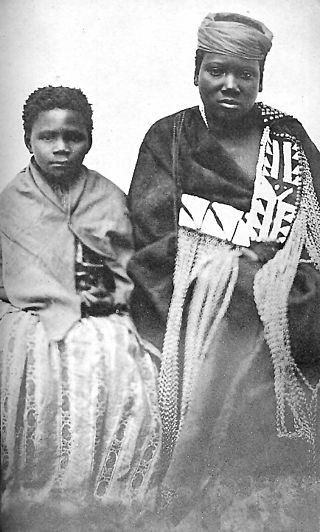
Nongqawuse was the Xhosa prophet whose prophecies led to a millenarian movement that culminated in the Xhosa cattle-killing movement and famine of 1856–1857, in what is now Eastern Cape, South Africa.

Kaffraria, Kaffiria, or Kaffirland was the descriptive name given to the southeast part of what is today the Eastern Cape of South Africa. Kaffraria, i.e. the land of the Kaffirs, is no longer an official designation.
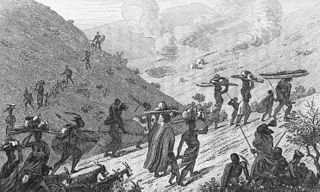
The amaMfengu was a reference of Xhosa clans whose ancestors were refugees that fled from the Mfecane in the early-mid 19th century to seek land and protection from the Xhosa. These refugees were assimilated into the Xhosa nation and were officially recognized by the then king, Hintsa. The term derives from the Xhosa verb "ukumfenguza" which means to wander about seeking service.

Qonce, or King William's Town, is a town in the Eastern Cape province of South Africa along the banks of the Buffalo River. The town is about 60 kilometres (37 mi) northwest of the Indian Ocean port of East London. It has a population of around 35,000 inhabitants and forms part of the Buffalo City Metropolitan Municipality.

British Kaffraria was a British colony/subordinate administrative entity in present-day South Africa, consisting of the districts now known as Qonce and East London. It was also called Queen Adelaide's Province and, unofficially, British Kaffiria and Kaffirland.
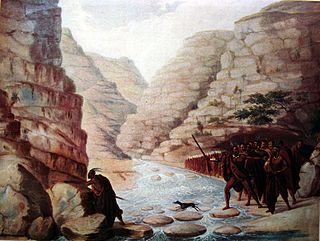
The Xhosa Wars were a series of nine wars between the Xhosa Kingdom and the British Empire as well as Trekboers in what is now the Eastern Cape in South Africa. These events were the longest-running military action in the history of European colonialism in Africa.

Butterworth, also known as Gcuwa, is a town in the Eastern Cape Province, South Africa. Butterworth has a population of 45,900 and is situated on the N2 national highway 111 km north of East London.
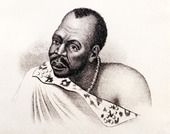
Hintsa ka Khawuta, also known as Great or King Hintsa, was the king of the Xhosa Kingdom, founded by his great ancestor, King Tshawe. He ruled from 1820 until his death in 1835. The Xhosa Kingdom, at its peak, during his reign stretched from Mbhashe River, south of Mthatha to the Gamtoos River, in the Southern Cape.

The Diocese of Grahamstown is a diocese of the Anglican Church of Southern Africa. It is centred on the historic city of Makhanda in the Eastern Cape Province of South Africa. The diocese extends to East London, in the east and Port Alfred to the south.

The Xhosa people, or Xhosa-speaking people are a Bantu ethnic group whose traditional homeland is primarily the Cape Provinces of South Africa. They are the second largest ethnic group in Southern Africa and are native speakers of the IsiXhosa language.
The Rharhabe House is the second senior house of the Xhosa Kingdom. Its royal palace is in the former Ciskei and its counterpart in the former Transkei is the Gcaleka, which is the great house of Phalo.

The Gcaleka House is the Great house of the Xhosa Kingdom in what is now the Eastern Cape. Its royal palace is in the former Transkei and its counterpart in the former Ciskei is the Rharhabe, which is the right hand house of Phalo.
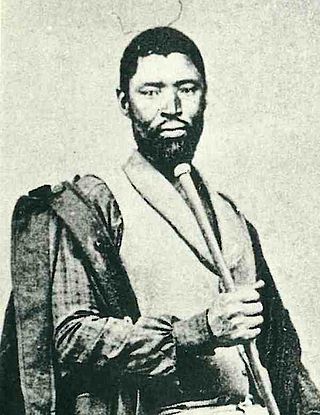
Mgolombane Sandile (1820–1878) was a ruler of the Right Hand House of the Xhosa Kingdom. A dynamic leader, he led the Xhosa armies in several of the Xhosa-British Wars.

The Ngqika people are a Xhosa monarchy who lived west of the Great Kei River in what is today the Eastern Cape of South Africa. They were first ruled by Rarabe kaPhalo who died with his son Mlawu, who was destined for chieftaincy. The clan would be named after Ngqika ka Mlawu, the son of the then late Mlawu. It would be years before the child would rule his people who fought in the Xhosa Wars, which were sparked by the encroachment of European settlers on Xhosa lands.

Thembuland, Afrikaans: Temboeland, is a natural region in the Eastern Cape province of South Africa. Its territory is the traditional region of the abaThembu, one of the states of the Xhosa nation.
The Imidushane clan was founded by one of the greatest Xhosa warriors Prince Mdushane who was the eldest son of Prince Ndlambe, the son of King Rharhabe.
Tsholomnqa is a rural area and village situated in Eastern Cape in South Africa in the Mdantsane District.
References
- ↑ "British Kaffraria, now the Border Region". South African History Online. Retrieved 28 December 2023.
- ↑ B.), Peires, J. B. (Jeffrey (2005). The house of Phalo : a history of the Xhosa people in the days of their independence. Jonathan Ball. ISBN 978-1868421596. OCLC 61529352.
{{cite book}}: CS1 maint: multiple names: authors list (link) - ↑ Mills, Wallace G. (August 1983). "Review: The House of Phalo: A History of the Xhosa People in the Days of Their Independence, by J. B. Peires, Berkeley, Calif., University of California Press, 1982". Canadian Journal of History. 18 (2): 265–267. doi:10.3138/cjh.18.2.265. ISSN 0008-4107.
- ↑ "Archived copy" (PDF). Archived (PDF) from the original on 19 August 2018. Retrieved 20 August 2018.
{{cite web}}: CS1 maint: archived copy as title (link) - ↑ "Home | Electronic Theses and Dissertations" (PDF). Archived (PDF) from the original on 11 September 2018. Retrieved 11 September 2018.
- ↑ Colin Bryden, All-Rounder: The Buster Farrer Story, Aloe Publishing, Kidd's Beach, 2013, p. 6.